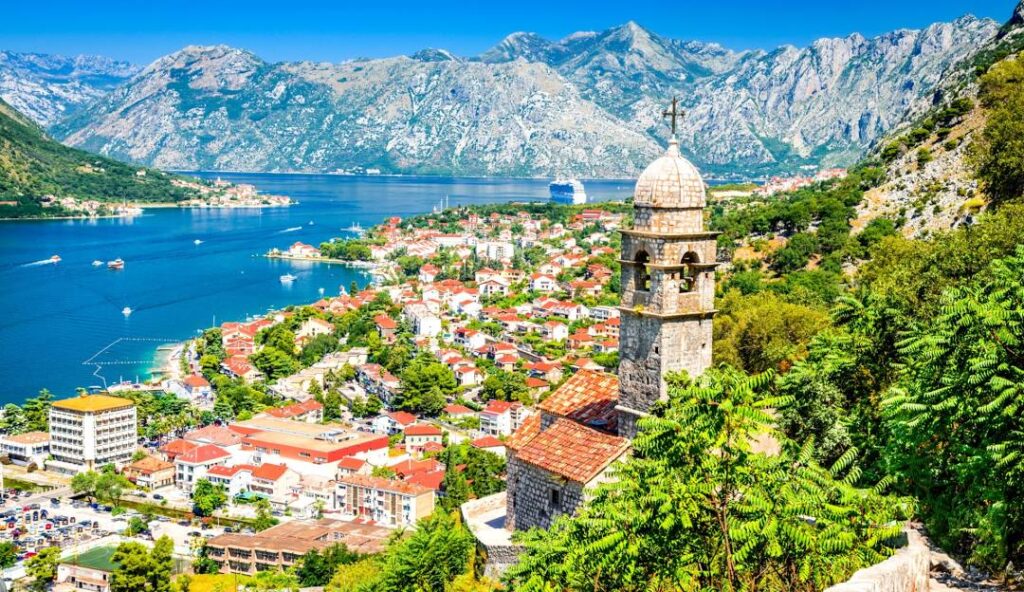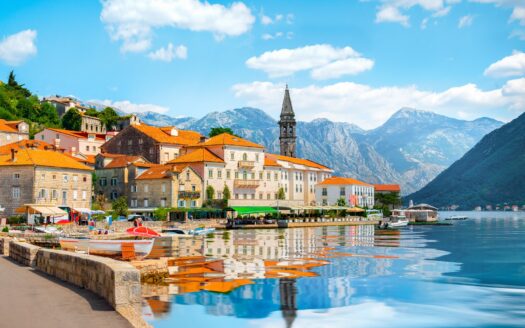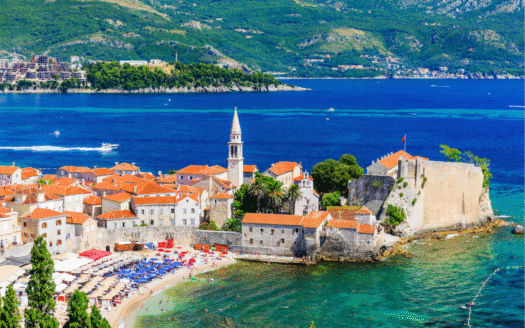Kotor, Montenegro Travel Guide: History, Attractions, and Tips for Your Visit

Kotor, located on the Adriatic coast of Montenegro, is one of the most captivating historic cities in the Balkans. With its medieval Old Town, dramatic mountain backdrop, and crystal-clear bay, Kotor offers an unforgettable travel experience that combines history, culture, and natural beauty. This article explores everything you need to know before visiting Kotor: its historical significance, must-see attractions, travel tips, and the best things to do during your stay.
Where Is Kotor Located?
Kotor is situated in the southwestern part of Montenegro, nestled within the Bay of Kotor (Boka Kotorska). This bay is often mistaken for a fjord due to its stunning geography, but it is technically a ria — a submerged river canyon. The city is surrounded by steep limestone cliffs and enjoys a unique blend of Mediterranean and Balkan influences.
Its strategic coastal location made Kotor a key maritime and trading hub throughout history. Today, it serves as a popular destination for both independent travelers and cruise ship passengers exploring the Adriatic.
The Historical Significance of Kotor
Kotor’s history spans over two millennia. It was founded by the Romans and later became part of the Byzantine Empire. From the 15th to 18th centuries, it was ruled by the Republic of Venice, whose influence is still visible in the architecture and urban layout.
The city walls, fortresses, churches, and palaces are well-preserved, earning Kotor a spot on the UNESCO World Heritage List in 1979. Despite its relatively small size, Kotor played a major role in maritime history and developed a rich cultural and architectural heritage.
Best Time to Visit Kotor
The best time to visit Kotor is between May and September, when the weather is warm and sunny. July and August are the peak tourist months, so for a quieter experience, consider visiting in late spring or early autumn.
Winter months are mild but much quieter, and some tourist services may be limited. However, this can be an ideal time for travelers seeking a peaceful and crowd-free atmosphere.
Top Attractions in Kotor
1. Kotor Old Town (Stari Grad)
Kotor’s Old Town is a labyrinth of narrow streets, small squares, and historical buildings. It’s completely pedestrianized and surrounded by medieval walls. The streets are paved with stone and lined with shops, cafes, churches, and museums.
Don’t miss landmarks like St. Luke’s Church, the Beskuća Palace, and Pima Palace, which reflect a mix of Gothic, Baroque, and Romanesque styles.
2. St. Tryphon’s Cathedral
Built in 1166, the Cathedral of Saint Tryphon is one of the oldest and most important Roman Catholic churches in the Adriatic region. It features twin towers, a rich collection of religious relics, and well-preserved frescoes. The cathedral is dedicated to the patron saint of Kotor and serves as a symbol of the city’s historical religious importance.
3. Kotor City Walls and San Giovanni Fortress
The medieval city walls of Kotor stretch over 4.5 kilometers and climb steeply up the hillside to the San Giovanni Fortress (St. John’s Fortress). The hike to the top involves more than 1,300 steps but rewards you with panoramic views over the bay and rooftops of the Old Town.
It’s recommended to go early in the morning or late in the afternoon to avoid the heat and crowds.
4. Maritime Museum of Montenegro
Located in a Baroque palace in the Old Town, the Maritime Museum highlights Kotor’s naval history. Exhibits include ship models, antique navigational tools, and artifacts from Kotor’s rich seafaring past.
This museum provides valuable context to the city’s development as a maritime power and is ideal for history enthusiasts.
5. Church of Our Lady of Health
Perched midway up the hill, this small church dates back to the 15th century and was built as a place of refuge during times of plague. It offers a beautiful viewpoint over the Old Town and bay.
Day Trips and Nearby Attractions
Perast and Our Lady of the Rocks
Only a 20-minute drive from Kotor lies the town of Perast, famous for its baroque architecture and two islets: Our Lady of the Rocks and St. George Island. You can reach the artificial islet of Our Lady of the Rocks by boat and explore its church and museum.
Perast is quieter than Kotor but equally rich in history, making it a perfect half-day trip.
Lovćen National Park
Located about 45 minutes from Kotor by car, Lovćen National Park offers hiking, panoramic views, and the famous Njegoš Mausoleum, which sits atop Mount Lovćen. From here, you can enjoy some of the best views of Montenegro, stretching all the way to the Adriatic Sea.
Budva and Sveti Stefan
If you’re interested in beaches and nightlife, consider visiting Budva, about 30 minutes from Kotor. Budva is known for its sandy beaches, vibrant nightlife, and luxury resorts. Nearby Sveti Stefan is a tiny island village turned exclusive hotel resort, offering postcard-perfect views.
Activities and Experiences
Hiking
Kotor offers several hiking routes, including the Ladder of Kotor, an old military path zigzagging up the mountain behind the town. This route offers breathtaking views and leads into Lovćen National Park.
Kayaking and Boat Tours
Exploring the Bay of Kotor by kayak or boat is highly recommended. Many companies offer half-day or full-day tours that include stops at nearby villages, islets, and swimming spots.
Culinary Experiences
Montenegrin cuisine in Kotor is a mix of Mediterranean and Balkan flavors. Try local specialties like:
- Black risotto (made with cuttlefish ink)
- Grilled sea bass
- Njeguški pršut (smoked ham)
- Cheese from Njeguši village
- Local wines and homemade rakija (fruit brandy)
Many restaurants in the Old Town offer outdoor seating in charming stone courtyards. For a romantic experience, book a dinner at a restaurant with views of the bay.
Accommodation Options
Kotor offers a wide range of accommodations:
- Luxury Hotels: Hotel Forza Terra, Huma Kotor Bay
- Boutique Stays: Hotel Monte Cristo, Palazzo Drusko
- Budget-Friendly Options: Old Town Hostels, private apartments
- Bayview Villas: For travelers seeking a quiet, scenic stay just outside the Old Town
It’s advisable to book in advance, especially during the summer months when tourism peaks.
Transportation and How to Get There
Kotor is easily accessible by road and sea. The nearest airport is Tivat Airport (TIV), just 10 km away. Podgorica Airport (90 km) and Dubrovnik Airport (Croatia) are also convenient for international travelers.
Public buses connect Kotor with major Montenegrin cities like Budva, Herceg Novi, and Podgorica. Rental cars are also popular, offering flexibility to explore remote areas.
Once inside the Old Town, no car is needed — it’s completely pedestrian and walkable.
Travel Tips for Visiting Kotor
- Start your day early to avoid cruise ship crowds.
- Wear comfortable shoes — the stone streets can be slippery.
- Carry cash, especially for small purchases and local shops.
- Stay hydrated, especially during summer hikes.
- Check cruise schedules, as the town gets busier on days when large ships dock.
Conclusion: Why Kotor Should Be on Your Travel List
Kotor offers an exceptional blend of history, architecture, and natural scenery. Its well-preserved medieval town, dramatic mountain setting, and peaceful bay make it a standout destination in the Balkans.
Whether you’re interested in ancient churches, coastal hiking, or simply enjoying the slower pace of life, Kotor provides a rich and rewarding experience. Add this Montenegrin gem to your travel itinerary — it’s a place you’ll remember long after your trip ends.


